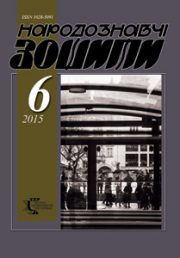The Ethnology Notebooks. 2021. № 3 (159), 689—699
UDK 738.012.016.02.03(477-25)”195″
DOI https://doi.org/10.15407/nz2021.03.689
EXTERIOR AND INTERIOR CERAMICS OF THE 1950’S KYIV EXPERIMENTAL WORKSHOP OF ART CERAMICS
SKOROMNA Alesia
- ORCID ID: http://orcid.org/0000-0001-8961-4524
- Ph.D student of the Department
- of Theory and History of Art,
- National Academy of Fine Arts and Architecture,
- 20, Voznesensky Descent St., 04053, Kyiv, Ukraine,
- Contacts: e-mail: dolzhenko2012@gmail.com
Abstract. The purpose of the article. The article, based on the study of archival materials and natural art sources, systematizes, attributes and analyzes selected artistic exterior and interior works of the 1950’s of the Kyiv Experimental Workshop of Art Ceramics, as well as outlines its main technological achievements.
Methodology provides for the unity of such approaches as the historical (introduction of ceramics into the artistic context — of the 1950’s and the development of objects in chronological order), factual (study of archival documents), method of comparative analysis (attribution of works of art, comparative typological comparison) and art history analysis (formal‑stylistic analysis to identify the style and formation of works).
Scientific novelty. A selected group of ceramoplastics of the Experimental Workshop made in the Stalin’s Empire‑style and the Ukrainian neo-baroque style of the 1950’s was introduced into scientific circulation, including the decoration of the educational institution № 1/185 of the Ministry of Internal Affairs of Ukraine «Berehynia» and archival documents of N. Fedorova. The attribution of the found works is carried out, their origin and author’s affiliation of technologist N. Fedorova, folk master O. Zhelezniak, professional ceramist O. Hrudzynska. It is formulated that the architectural and decorative ceramoplastics of the workshop in the 1950’s in terms of manufacturing technology and style had two directions: mixing poly- and monochromy in exterior ceramics (terracotta and enamel) and polychrome exterior and interior products (solid covered with enamels).
Conclusions. It was found out that in 1952—1959 the workshop was engaged in the design of preschools, administrative and residential buildings in Kyiv, Poltava and Cherkasy regions. The main technological achievements of the 1950’s were developed majolica enamel glaze of restorative fire based on copper compounds regenerative by N. Fedorova in 1956 and the revival of the technology of painting on raw enamel. Implementation in practice of the new methods proposed by O. Hrudzynska: enamels on enamel, painting with ceramic paint and watering restorative fire on a terracotta shard. The collected and analyzed factual material allows to illustrate certain observations regarding the appeal in ceramoplastics, in particular O. Hrudzynska to zoo- and phytomorphic motifs, light matte terracotta and enamels.
Keywords: Ukraine, 1950’s, exterior and interior ceramoplastics, unleaded and lead‑free enamels, terracotta, ornament, N. Fedorova, O. Hrudzynska, O. Zhelezniak, Experimental workshop.
Received 20.04.2021
REFERENCES
- Sakovych, I., & Bazhan, M. (Ed.). (1968). Decorative and applied arts. Ceramics. History of Ukrainian art. Soviet art of 1941—1967 (Vol. 6, pp. 359—363). Kyiv: IMFE im. M. Rylskoho NAN Ukrainskoj RSR [in Ukrainian].
- Kolomiecz, N., & Vejmarn, B. (Ed.). (1977). Art of the Ukrainian Soviet Socialist Republic. Architecture Art history of the peoples of the USSR. The art of the peoples of the USSR during the Great Patriotic War and until the end of the 1950’s (Vol. 8, pp. 167—210). Moskva: Izobrazitelnoe iskusstvo [in Russian].
- Kolomiiets, M. (1973). Problems of formation of modern architecture of the Ukrainian RSR. Kyiv: Budivelnyk [in Ukrainian].
- Musienko, P. (1953). Ceramics in architecture and construction (methods of decorating ceramic products). Kyiv: Academy of architecture of Ukrainian SSR [in Russian].
- Manucharova, N. (1950). Artistic ceramic detail (experience of Kyiv architects). Visnyk akademii arkhitektury Ukrainskoi RSR, 2, 20—25 [in Ukrainian].
- Muzychenko, S. (1974). Creators of the rainbow. Narodna tvorchist ta etnohrafiia, 3 (127), 77—81 [in Ukrainian].
- Beketova, I. (2007). Experimental workshop. Kupola, 4, 70—72 [in Ukrainian].
- Istomina, H., Studnytska, M., Skrypnyk, H., & Kara‑Vasyl’ieva, T. (Ed.). (2016). History of decorative art of Ukraine. Art of the XX — early XXI century. Architectural and decorative ceramics (Vol. 5, pp. 129—137). Kyiv: IMFE im. M.T. Rylskoho NAN Ukrainy [in Ukrainian].
- Veligoczkaya, N. (1965). Ceramics by Oksana Hrudzynska. Dekorativnoe іskusstvo, 7, 44 [in Russian].
- About the work of the ceramic workshop of the Institute of Arts Industry of the AA of the USSR. TsDAMLM Ukrainy (Tsentr. derzh. arkhiv-muzei liter. i myst. Ukrainy). F. 1113. Op. 1. Od. zb. 92. Ark. 1—76 [in Russian].
- Varvartsev, M., Drach, I., Musiienko, P. and others. Essays, articles and poems about O. Zhelezniak. TsDAMLM Ukrainy (Tsentr. derzh. arkhiv-muzei liter. i myst. Ukrainy). F. 1113. Op. 1. Od. zb. 78. Ark. 1—88 [in Russian].
- Hrudzynska, O. (2020). Audio recording of an interview with a ceramist from 26.10.2020 [in Russian].
- Characteristics, explanatory notes, articles, invitations, etc. TsDAMLM Ukrainy (Tsentr. derzh. arkhiv-muzei liter. i myst. Ukrainy). F. 1113. Op. 1. Od. zb. 76. Ark. 1—47 [in Russian].
- About the work of the Experimental ceramic workshop of the Institute of Arts and Crafts of the AA of the USSR. TsDAMLM Ukrainy (Tsentr. derzh. arkhiv-muzei liter. i myst. Ukrainy). F. 1113. Op. 1. Od. zb. 93. Ark. 1—29 [in Russian].
- About the work of the Experimental ceramic workshop of the Institute of Arts and Crafts of the AA of the USSR. TsDAMLM Ukrainy (Tsentr. derzh. arkhiv-muzei liter. i myst. Ukrainy). F. 1113. Op. 1. Od. zb. 94. Ark. 1—69 [in Russian].
- About the work of the ceramic workshop of the institute of architectural constructions AB and A of the USSR. TsDAMLM Ukrainy (Tsentr. derzh. arkhiv-muzei liter. i myst. Ukrainy). F. 1113. Op. 1. Od. zb. 96. Ark. 1—88 [in Russian].
- About the work of the Experimental ceramic workshop. TsDAMLM Ukrainy (Tsentr. derzh. arkhiv-muzei liter. i myst. Ukrainy). F. 1113. Op. 1. Od. zb. 97. Ark. 1—8 [in Russian].






